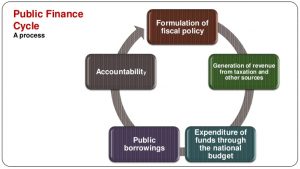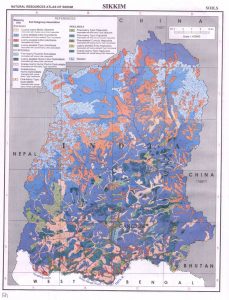Sikkim Food security
Food Security Index of India as well as Sikkm
- In India, the dimension of food security is important despite attaining self-sufficiency in food production. Though there has been a considerable improvement in productivity and production of rice and wheat, we have not been able to eliminate chronic hunger and poverty. Understanding of the different dimensions of food security, therefore, is of critical importance.
- The concept of food security in the Indian context has been increasingly refined during the last 50 years.
- After World War II, food security meant building emergency grain reserves and ensuring the physical availability of food in the market.

- After the onset of green revolution in the late 1960s, it became obvious that economic access to food is equally important to ensure food security at the household level.
- During the 1980s, the principle of social access was emphasised, with special reference to marginalised communities and gender discrimination.
- After the United Nations Conference on Environment and Development (UNCED) conference in Rio de Janeiro, there has been an increasing recognition of the role of environmental factors in food security.
- The ecological foundations essential for sustained agricultural progress are increasingly under stress due to human activities.
- One of the early initiatives in assessing the food security scenario in the country was the release of a series of Atlases by M.S. Swaminathan Research Foundation (MSSRF) that looked into the food security in rural and urban areas and also the Sustainability of Food Security atlas of India.
- Ensuring food security is an overall objective of development programmes in most developing economies like India. Several problems, such as hunger, malnutrition, under-nutrition and poverty, Association between Food Insecurity and Poverty Poverty Low productivity Human Development Food insecurity, hunger & Malnutrition Poor physical & Cognitive development arise due to food insecurity.
Historical View on Food Security across India as well as Sikkim
- India‟s Public Distribution System (PDS) is the largest distribution network of its kind in the world. PDS was introduced around World War II as a war-time rationing measure.
- Before the 1960s, distribution through PDS was generally dependant on imports of food grains.
- It was expanded in the 1960s as a response to the food shortages of the time; subsequently, the government set up the Agriculture Prices Commission and the Food Corporation of India to improve domestic procurement and storage of food grains for PDS.
- By the 1970s, PDS had evolved into a universal scheme for the distribution of subsidised food.
- In the 1990s, the scheme was revamped to improve access of food grains to people in hilly and inaccessible areas, and to target the poor.
- Subsequently, in 1997, the government launched the Targeted Public Distribution System (TPDS), with a focus on the poor.
- TPDS aims to provide subsidised food and fuel to the poor through a network of ration shops.
- Food grains such as rice and wheat that are provided under TPDS are procured from farmers, allocated to states and delivered to the ration shop where the beneficiary buys his entitlement.
- The centre and states share the responsibilities of identifying the poor, procuring grains and delivering food grains to beneficiaries.
- In September 2013, Parliament enacted the National Food Security Act, 2013.
- The Act relies largely on the existing TPDS to deliver food grains as legal entitlements to poor households.
- This marks a shift by making the right to food a justiciable right. In order to understand the implications of this Act, the note maps the food supply chain from the farmer to the beneficiary, identifies challenges to implementation of TPDS, and discusses alternatives to reform TPDS.
Sikkim Food Security also based on National Food Security
- The National Development Council (NDC) in its 53rd meeting held on 29th May, 2007 adopted a resolution to launch a Food Security Mission comprising rice, wheat and pulses to increase the production of rice by 10 million tons, wheat by 8 million tons and pulses by 2 million tons by the end of the Eleventh Plan (2011-12).
- Accordingly, a Centrally Sponsored Scheme, ‘National Food Security Mission’ (NFSM), was launched in October 2007.
- The Mission is being continued during 12th Five Year Plan with new targets of additional production of food grains of 25 million tons of food grains comprising of 10 million tons rice, 8 million tons of wheat, 4 million tons of pulses and 3 million tons of coarse cereals by the end of 12th Five Year Plan.
- The National Food Security Mission (NFSM) during the 12th Five Year Plan will have five components
- NFSM- Rice;
- NFSM-Wheat;
- NFSM-Pulses,
- NFSM-Coarse cereals and
- NFSM-Commercial Crops.
Area Coverage under NFSM from 2016-17 onwards:
- From 2016-17, NFSM is implemented in 638 districts of 29 states.
- NFSM-Rice is being implemented in 194 districts of 25 states.
- NFSM-Wheat is being implemented in 126 districts of 11 states.
- NFSM-Pulses is being implemented in 638 districts of 29 states
- An NFSM-Coarse cereal is being implemented in 265 districts of 28 states.
Sikkim Food Security and Related Department work
- Since independence, the Government of India has been implementing various schemes focusing on the poor for their upliftment. The government at the center as well as in the state has introduced various schemes whereby enabling the poor to at least two square meals in a day. Development would lose its meaning to a hungry man.
- Mahatma Gandhi once said that “A STARVING MAN COULD ONLY UNDERSTAND GOD IN THE FORM OF BREAD”.
The Food & Civil Supplies & Consumer Affairs Department of Government of Sikkim
- The Food & Civil Supplies & Consumer Affairs Department is entrusted with the task of implementing the Public Distribution System that envisages providing quality food grains, at subsidized rates and to ensure equitable distribution. The department has the dual duty of procuring and distributing food grains and petroleum products as well as monitoring and enforcing regulatory orders of the government.
Functions the Food & Civil Supplies & Consumer Affairs Department of Government of Sikkim
The main functions of Food & Civil Supplies & Consumer Affairs Department are:
- Procurement of food-grains covered under Targeted Public Distribution System (TPDS) from Food Corporation of India as per allotment.
- Transportation, storage and distribution of food-grains and other essential commodities in the state through a chain of Govt. Food Grain Godowns, Identified Fair Price Shops/Retail Shops, MPCS and Consumer Co-operative Societies (CCS).
- Ensure regular availability of food grains and other essential food commodities.
- Provide ration cards to the residents of the state.
ESSENTIAL COMMODITIES COVERED UNDER TPDS of SIKKIM
- Rice and Sugar -Being made available directly to the consumers all over the state through Govt. Food Grains godowns /Fair Price Shops/MPCS.CSS and through Ration Cards
- Wheat and Iodized Salt -APL category Whole Meal Atta and Iodized salt is being made available with the assistance of Nominees and Agents appointed by the State Govt. through Fair Price and other shops.
- Blue Dyed Kerosene (SK Oil)Procured by Dealers appointed by Oil Companies , is made available for the consumption of general consumers by the Department through identified Fair Price and other authorized retail shops.
Sikkim Government Major Initiative for food Security and Welfare of People of Sikkim
Mukhya Mantri Antodaya Annadan Yojana of Sikkim Govt:
- The poorest of the poor from the 43,428 BPL families earlier identified were further identified for the Antodaya Annadan Yojana Scheme.
- The 9914 beneficiaries under this scheme are entitled to 35 kgs of rice @3 /- per kg per month.
- The State Government however rechristened the name of the Scheme to Mukhya Mantri Antodaya AnnadanYojana from 23rd August 2003 and 9914 Families are provided 35 kgs of rice free of cost, 347 MTs of rice is distributed under this scheme to the beneficiary families.
Expanded Antodaya Annadan Yojana of Sikkim Govt:
- The Government of India allocates 578 MTs of rice under the Antodaya Anna Yojana out of which 347 MTs of rice is distributed under the MMAAY scheme, and the remaining 231 MTs of rice is distributed to 6600 families under this scheme.
- The beneficiaries are issued 35 kgs of rice @3/- per kg per month.
Annapurna Scheme of Sikkim Govt:
- Under this scheme helpless aged people above the age of 65 years who have no one to support them and are eligible for National Old Age Pension but have not received them are provided with 10 kgs of rice free of cost.
- The beneficiaries of this scheme have been provided rice from April 2000.
- A total of 2500 beneficiaries are availing rice under this scheme.
- A separate and distinct Ration Card has been provided to the beneficiaries free of cost
Whole Wheat of Sikkim Govt:
- The Government of India allocates 245 MTs of whole wheat to the State.
- For the convenience of the public it is ground into whole meal atta and distributed to ration card holders at the scale of 1 kg per individual @8.92 per kg per month through Fair Price Shops and other designated shops.
- The State also received 1145 MT of wheat as special adhoc allotment during the year. This was sold at the rate of 12/- per kg/ per person.
Levy Sugar of Sikkim Govt:
- The State of Sikkim is allotted 391 MTs of Levy Sugar per month.
- Consequent upon the inability of supplying levy sugar by the Food Corporation of India from their depots in the State, the State lifts the allotted quota by engaging an agent directly from various Sugar Mills, of Uttar Pradesh.
- The sugar is transported by road to Siliguri and further transported to different Food Godowns in the State.
- The retail sale price of levy sugar has been fix at 25.40 per kg inclusive of transportation cost. Effort is being made by the Department to avail subsidy under “Price Equalization Fund” to enable the Government for distributing levy sugar at a lower price.
Kerosene Oil of Sikkim Govt:
- Sikkim is allotted 546 KL of Kerosene Oil per month.
- This is issued through Fair Price Shops/Ration Cards at a scale of 1.25 litres per individual in rural areas and 1 litre in the urban areas.
Ration Cards of Sikkim Govt:
- Apart from the distinct family ration cards for BPL families the department has issued 4, 30,547 individual APL ration cards with digital computerized photos imprinted on it.
- An individual above the age of five years is entitled to a ration card on production of documentary proof that he/she is a local resident.
- Effort is being made to issue new biometric ration cards to weed out bogus/duplicate ration cards.
Fair Price Shops of Sikkim Govt:
- There are 1420 approved Fair Price Shops including Co-operative Societies all over the State. All the Fair Price Shops are registered with the Department.
- The Fair Price Shops are required to deposit a sum of 5000/- (five thousand) as security deposit which is returned if the Fair Price Shop wants to surrender their licence.
- The District wise break up of Fair Price Shops is as under:-
- South 420 North 74 West 336 East 590 Total 1420

